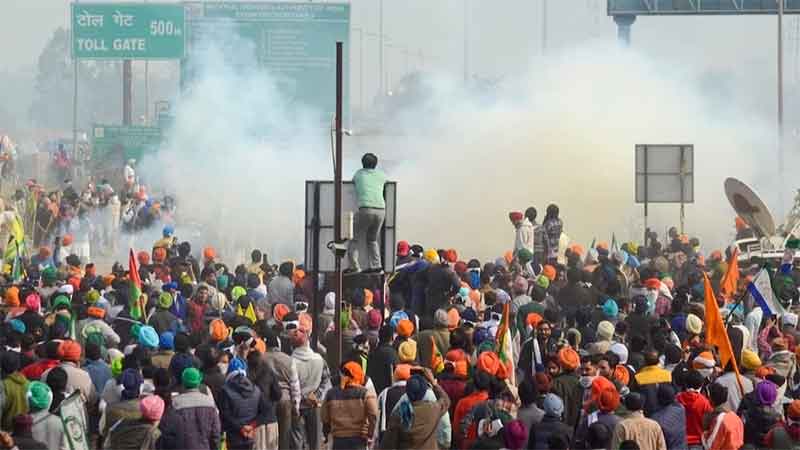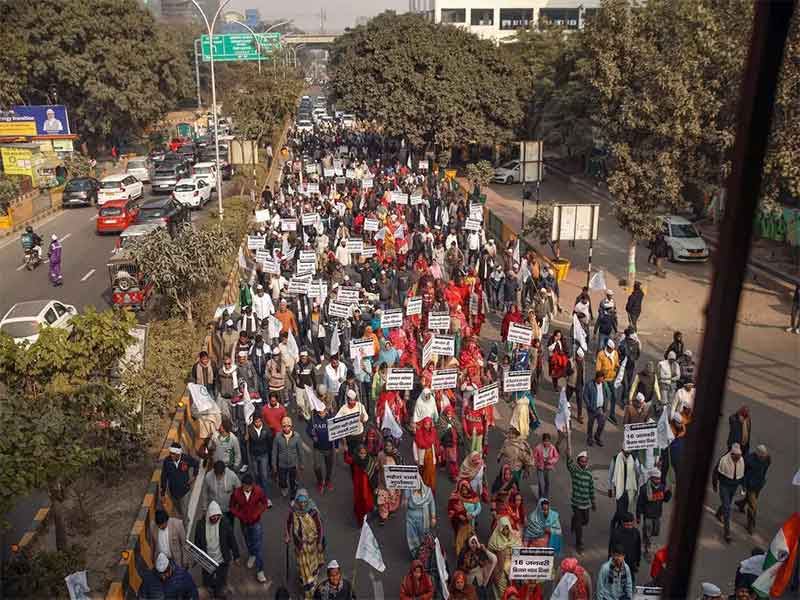
‘Such is your state;
This is the cause;
Remove the cause.’
-Ved Prakash Varuk
Constantly forged in the crucible of struggles and resistance the peasant farmers’ protest reveals the transformative resolve to constitute a new Republic. To chart a more comprehensive emancipatory alternative, and negate frightening modes of domination, dispossession and racial hierarchy. The peasant insurgents endowed with a surfeit of ‘acute historical consciousness are the bearers of potential alternatives. Who by their defiant gathering on the highways to Delhi keeps alive the flames of resistance lit by past insurgencies – a continuing movement of people towards autonomy.
The peoples’ new Republic resisting the Farm Bills is the constitutive act of the masses ‘challenging the newest frontier for capital to extract profits from agriculture’ (Richard C. Lewontin). Contrary to the Prime Ministers promise of ‘ache din’ by “integration” of Indian farmers into the global agribusiness network: the insurgents have torn apart the Promise Makers declarations as mere hogwash. An integration that will serve to convert more farmers into essentially being a the proletariat that normally “owns” but has lost control over, its own land. What Marx predicted as the ‘separation of the bulk of the population from the land, being the means of production was the the threat of dispossession identified and opposed by the peasant insurgent farmers…
Sown into the declaration of a new Republic the peasant insurgents have demanded a critical reading of the dominant narratives – that mask underlying realities – peddled by the privileged elites.
A declaration resonating against the silent acceptance of age-old cultural practices that strive on ontologies of inferiority: structured in the name of Manu to the oppressive anti-dalit-bahujan strands of Indian nationalism. Punching a hole in the violent jurisprudence of deprivation facilitating plunder by the privileged elites justified by rules of law “churned out at the rate of a Bill in seven minutes” by the Lok Sabha. (Derek O’Brien)
Challenging the Bills clapped-into-force by the captured ethnic Parliamentary majority, the constituent assembly of insurgents are unravelling the narratives of domination scripted by the brahmin pathocracy. The exit of colonial Britain celebrated as national independence was not the end of injustice and inequality. But the post-colonial state led by the brahmin led privileged elite perpetuated the kind of oppression and exploitation carried out by colonial rulers. Except it was now in the name of the nation: morphing into Hindutva, the ethnic plutocracy structured by the brahmin-baniya-hegemony. Against this dominant narrative, the new Republic exposes the fiction of national sovereignty and independence granted by the British Raj and accepted by the privileged elite: the colonial collaborators. Re-interpretation of such fiction is a necessary prelude to transformative change.
Such struggles for change gives rise to unique insights, diverse languages of revolt, and alternative ways of thinking. Representing peoples’ change from submission to a transformative autonomous force currently resisting agricultural capitalism in battleground India. To stave off imminent death by hunger, the peasant insurgents demand the immediate repeal of Farm laws. Being statutes that – ratify the exploitative Mumbai-Amdavad hegemony – failed the test of peoples’ acceptance. Along the highways of North India, superimposed over past landscapes of the Indian Revolution of 1857 is the throbbing multitude: displaying the overriding sovereign power of the people. Walking in Defiance a weapon of assertion – against the dishonest ethnic majoritarian – calling to account a failed representative democracy: a disaster.
Embedded in the current peasant insurgency are the glowing embers of past rebellions. That earlier erupted as spasms of rage and resistance across Rajputana, United Provinces, Bihar, Bengal against the British East India Company including the Rangpur dhing (1783), the Birzaite ulqulan (1899). People, sub-nationalities, tribal, – presumed culturally, socially, economically inferior – peasants, outcasts of the region raised the banner of revolt against dispossession by the colonial East India Company.
By resisting the State-sponsored racket of exploitation, and land appropriation, insurgents continue to invoke the pre-Independence ‘tradition which opposes’. The tradition of the colonial era revolt now rumbles as low-level resistance, with the symbolic attacks on elite property and status particularly in the locations of the Mutinies in Northern India. Constantly re-writing modes of struggles, the new Republic calls out the falsities propagated by the dominant class forcing the people to make false choices and wasting lives in the worship of false gods who thwarted the national movement of people towards emancipation by uprooting the British colonial rule.
The initial success of the revolutionary mass movement towards peoples’ emancipation lost its momentum in 1922 when Gandhi called off the non-cooperation movement on the pretext of violence at Chauri Chaura. The anticipated national rebellion against colonial Britain was averted by the pacifist declarations of the saint-like Gandhi: the ‘brake’ that facilitated the British Raj to hand over the reins of power to the chosen upper caste privileged elite (Perry Anderson). Today resisting the new peoples’ Republic white-beard-saint-Modi is the ‘reverse’ gear taking India back to the mythical glorious Pauranic era. Yet offering public wealth on a platter to the desi oligarchs serving forces of finance capital. The Prime Minister the scarecrow, about to be fitted with star-spangled on his turban presiding over the accumulation of national wealth by the brahmin-baniya hegemony as the prop.
The role of Modi as the lead collaborator of the US Empire trudging along the lines drawn by the Washington Consensus accepting the status of ‘willing captive’ stands exposed by the new Republic. As policies are crafted to force workers as captives to sell their strength for starvation wages. Structured by the magic wand of legislative power millions of Indians ready to work must depend on the goodwill or rather the greediness (slashed wages) offered by select few cronies. The consciousness of the people displays distinct sovereignty –unbound- of the people by their acts of rejection, insubordination and self-assertion of the gathering multitude.
Birthed in the reconstituted Republic is the demand to probe history to identify colonialism that continues to survive the namesake republic and independent India. Wilfully plugged into the net cords of global capitalism, the Prime Minister – like other global despots – upholds the exploitative racket of the Western India oligarchs ensuring continuing subordination to the sovereignty of global capital. The Parliament of the people congregating along the highways to Delhi, the panchayats of Northern India and Jantar Mantar represents the will of the people conscious of the false sense of independence. A gathering willing to override the injustices accumulated by centuries past, demanding displacement of wealth and dismantling of political power consolidating in the hands of the palanquin bearers of the Prime Minister.
Within India, the Prime Minister, bound by a Faustian pact to the brahmin-baniya hegemony; that transformed his image from the pogrom-in-chief of Gujarat to the Hindu Hrideya Samrat. The swayam sevak leading a Government committed to disposing of public assets to nudge the upward movement of the select desi oligarchs on the Forbes List. As wealth disparity grows, the new Republic, through the mahapanchayats has given rise to peoples initiatives evidencing dormant sub-national alternatives, for redistribution of wealth and services. Such popular initiatives bring in economic revolution, calling out the abject failure of the body of representatives elected and on sale to the highest oligarchic bidder consortium through sealed Electoral Bonds, and contributions to the PMsCARES Fund.
The insurgent multitude consisting of men, women, landless agricultural labourers, Dalits, Adivasis, Buddhists, Sikhs and marginalized people are political beings and so are ‘legislators’ (Gramsci). The multitude by their gathering giving shape to the new Republic is a type of political practice of people acting in common, demanding what is for the common good. To grasp the nature of the gathering multitude will help light a lamp in the fascist darkness oozing over India. The right-wing regime in India facilitates the all-encompassing growth of fascism but there are serious alternatives raised by peasant insurgents. When the people ‘see the light’ in the darkness they have seen enough ‘including ‘how to go beyond it’.
Vinod Kumar Edachery works with a strategic advisory in the Middle East. He believes that neoliberalism creates inequality and transfers wealth to the hegemony. Email: [email protected]














































